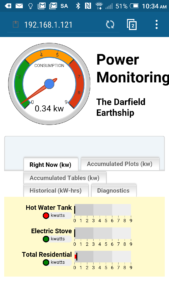
Last year I started monitoring our residential electrical usage with the goal of reducing our consumption (I talked about it a few times too … here, here and here again).
So, finally it’s a year later – how did we do? My ultimate goal is to lower our electrical consumption so that we can then move forward with generating our own electricity. The reason for lowering our consumption first is that it is a lot easier and less expensive to reduce consumption than it is to generate power to meet our current use. My goal is electrical consumption/generation of 5 to 10 kwh/day. Currently we use about 20 kwh/day so we still have some work to do if we want to cut this number in half!
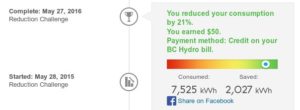 To give myself some incentive, last year I enrolled in the BC Hydro PowerSmart challenge. By reducing consumption by 10% over the course of one year (based on the previous year’s consumption) BC Hydro will issue a rebate of $50.00 at the end of the challenge. So, good news! We went from consumption of 26 kwh/day to about 20 kwh/day. In dollar terms this represents a savings of about $250 dollars. This figure comprises the $50 rebate that was put against our Hydro bill last week, and the 2000 kwh we did not use (valued at $0.1/kwh).
To give myself some incentive, last year I enrolled in the BC Hydro PowerSmart challenge. By reducing consumption by 10% over the course of one year (based on the previous year’s consumption) BC Hydro will issue a rebate of $50.00 at the end of the challenge. So, good news! We went from consumption of 26 kwh/day to about 20 kwh/day. In dollar terms this represents a savings of about $250 dollars. This figure comprises the $50 rebate that was put against our Hydro bill last week, and the 2000 kwh we did not use (valued at $0.1/kwh).
The fascinating thing about this annual reduction (to me anyway) is that we really did not do all that much to do this. We were just more mindful of what we were consuming on a daily basis.
How I Monitor
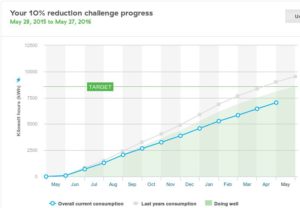 I started with a basic online tool available to every BC Hydro customer, the BC Hydro Customer portal. This web interface allows tracking of daily consumption in hourly increments, and is also the home of the PowerSmart Challenge. This tool is useful and allows a customer to download consumption history as a spreadsheet. But, the hourly data is not very granular and the lack of real time feedback was frustrating. I wanted more data! (Note that despite my frustrations you can very effectively track your Hydro consumption with these online tools).
I started with a basic online tool available to every BC Hydro customer, the BC Hydro Customer portal. This web interface allows tracking of daily consumption in hourly increments, and is also the home of the PowerSmart Challenge. This tool is useful and allows a customer to download consumption history as a spreadsheet. But, the hourly data is not very granular and the lack of real time feedback was frustrating. I wanted more data! (Note that despite my frustrations you can very effectively track your Hydro consumption with these online tools).
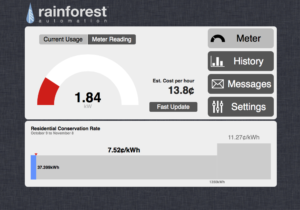 So, I graduated to the RainForest real-time monitoring hardware available to anybody with a smart meter. Again, this is another useful tool as it allows you to watch your power consumption second by second. If everyone in the house is running hair dryers at the same time you can immediately see the total household consumption jump and take immediate action! This tool has some problems including:
So, I graduated to the RainForest real-time monitoring hardware available to anybody with a smart meter. Again, this is another useful tool as it allows you to watch your power consumption second by second. If everyone in the house is running hair dryers at the same time you can immediately see the total household consumption jump and take immediate action! This tool has some problems including:
- Range – my BC Hydro meter is about 200′ from the house and this is just about the limit for this hardware to work reliably. The connection drops occasionally. This seems to be weather dependent.
- Reliability – It crashes and has to be rebooted periodically. This is a bit frustrating but not the end of the world.
- Slightly broken API – I now use this hardware as part of my overall monitoring tool (see below) and the API to download metered data was working well and now seems somewhat broken since the last update I installed from RainForest. Again, frustrating but I have not taken the time yet to identify the actual problem that is causing this. My guess is that the API that allows 3rd party downloads was inadvertantly broken as part of their most recent upgrade. I assume this as everything was working, then I installed the upgrade and a few things stopped working.
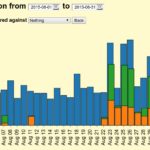 I’ve graduated to my own web-based monitoring tool written with Python, PHP, JavaScript and w3.ds. This tool allows me to monitor individual appliances (currently the stove and the hot water tank) as well as overall consumption in real time. Also, historically, it gives me a very granular view of what is happening and where the power goes. The image to the left shows power consumption in August when we were canning peaches and tomatoes. Power use spiked from washing all those jars and using the stove to can all day.
I’ve graduated to my own web-based monitoring tool written with Python, PHP, JavaScript and w3.ds. This tool allows me to monitor individual appliances (currently the stove and the hot water tank) as well as overall consumption in real time. Also, historically, it gives me a very granular view of what is happening and where the power goes. The image to the left shows power consumption in August when we were canning peaches and tomatoes. Power use spiked from washing all those jars and using the stove to can all day.
The best part … I’ve moved beyond monitoring to control! The screen shot at the top of the post is the monitoring tool on my android phone, and the red button beside the hot water tank means that it is currently turned off. I can turn appliances (sadly, only the hot water tank right now) on and off via a schedule and in real time by clicking on the associated button on the web page. I should mention that I think this is the best part … everybody else not so much. The rest of my family is getting pretty tired (freaked out?) of answering questions about who is using the stove after I see something odd happening remotely and I call in to begin the “inquisition”.
What I Found From Monitoring
The biggest takeaway for me was that making electrical consumption ‘visible’ through monitoring meant that we used less of it. Generally, household electrical consumption is hidden because it is invisible and makes little to no noise, making it very easy to ignore. The TV/satellite box/PS3 centre in our living room was a glaring example in our house; the satellite box was on all of the time and it was only after turning these devices off when not in use (most of the day) that I learned what a power hog the satellite box is. We barely watch TV – we currently have free rural LTSS service — but the satellite is updating the schedule constantly. This constant updating is energy intensive (do not ask me why). By only turning the unit on while actually watching TV, a noticeable drop in daily energy consumption occurred.
Some things that stood out for me:
- Phantom loads like the satellite box discussed above. I should add here that we have too many electrical devices to count in our house; 5 computers, a printer, 4 smart phones … you get the idea. I am going to hazard to guess that 10-20% of our electrical consumption is devoted to these devices. I have not experimented too much here as I fear for my life on this one.
- The fridge and freezer. We use a really old freezer and about midway through last year our old fridge finally died, and it was a bit of a relief. I spent a lot of my time justifying the smell, water leaks and noise as TOTALLY NORMAL right to the bitter end. Instead of buying a new fridge we bought a chest freezer and converted it into a really super-efficient fridge. I am estimating we saved 1.5 – 2 kwh/day with this change. Until recently – very recently, and certainly for the entire duration of the BC Hydro challenge – our freezer was a 20-year-old 9 cubic foot unit.
![the_year_breakdown]() Domestic hot water. I am beginning to think DHW is our bad joke on the world (and we will be trying to explain it for decades to come). In our house at least 41% of the electricity used is for domestic hot water, and that mostly means showers for five people. This is our biggest area for dropping consumption and when you really think about having a tank of EXTREMELY hot water available all the time you have to wonder who came up with the whole instantaneous hot water idea in the first place. We made some inroads here (at least 10% of our original consumption) by turning the hot water tank off for 1/2 of the day.
Domestic hot water. I am beginning to think DHW is our bad joke on the world (and we will be trying to explain it for decades to come). In our house at least 41% of the electricity used is for domestic hot water, and that mostly means showers for five people. This is our biggest area for dropping consumption and when you really think about having a tank of EXTREMELY hot water available all the time you have to wonder who came up with the whole instantaneous hot water idea in the first place. We made some inroads here (at least 10% of our original consumption) by turning the hot water tank off for 1/2 of the day.- Our second biggest consumer is the electric stove (see the above image). Canning days were particularly hard on me this year.
What’s Next
We just bought a new freezer last week. When we switched to a chest fridge last year we lost the small freezer that was part of our old fridge and we’ve simply run out of room in the fairly small chest freezer. This is the time of year we start harvesting and just the meat birds alone that we finished and harvested last week meant we we’ve been storing chicken with family. The old freezer was really old (pre 1990?) and ran all the time. I am going to go out on a limb here and predict that even with the larger freezer we will see a reduction in energy consumption.
I’ve already said it. Our biggest potential savings are reducing the electrical consumption associated with DHW and the electric stove which combined account for over 50% of the electrical consumption last year. The question is how …
Propane Stove and Hot Water?
We could switch to propane for the stove and DHW. This would immediately put is in the target range I’ve set for generating our own electricity. However, the goal has always been to generate our own power, not to switch from electricity to fossil fuels. Because of this I’ve never seriously considered this option. I really would like to avoid this step.
Waste Vegetable Oil?
We run both our vehicles (a VW jetta and a Delica van) on waste vegetable oil (WVO), and it works really well. This was a serious contender for a while; last year we had more WVO supply than we knew what to do with, and a stove and hot water tank run on WVO would not be that different from using heating oil (this is just diesel or bunker fuel by another name) or methane from a biodigester (different issues but ultimately the same result). I abandoned this idea for a number of reasons; smell, mess and potential fire hazard being high on the list.
Heat Capture & Solar Hot Water for DHW
This is ultimately the route we plan to take.
Heat capture is pretty simple. Instead of showering with hot water and then flushing it straight down the drain the idea here is to reuse the heat, reducing the energy required to keep the shower water hot. This idea is already commercially available and not that hard to implement. I am more interested in the idea of recycling the actual flow of water used in the shower, saving on both heating and water use. Think of Chris Hadfield in the space station, he re-used everything (I mean everything), and I am just talking about recirculating the shower water. This idea is not commercially available but could save 90% of the electricity and even more of the water associated with a typical shower.
Once the DHW consumption is reduced using heat capture a solar hot water system makes total senses to me. I would like to start on the heat capture idea this summer. Like today. I’ve already started spec-ing out the parts!
Solar and/or Wood Fired Oven
We’ve been playing with this idea over the last year. We replaced the top of our rocket mass heater wood stove, and this allowed us to do some cooking on this stove top through the winter. The ultimate here would be a wood fired oven in the kitchen; it would contribute to heating and would allow us to do most of our cooking without electricity in the colder months. This idea requires lots of time; both to build it and to cook this way. I am not sure this is in our immediate future as Sandra and I are committed to a work contract until the end of the calendar year. That, combined with sending Katie on her way into the wide world of acting school in September, and another two years of homeschooling Stephen and Helen, makes us pause even more and set priorities that will be fun, doable and leave at least a little time to spent together as a family.
So, while we haven’t been really busy bloggers the last year, I do plan on documenting this project as I have in the past. It’s all part of our commitment to sharing what we are doing. Hope you enjoy this project as much as I am planning to!
